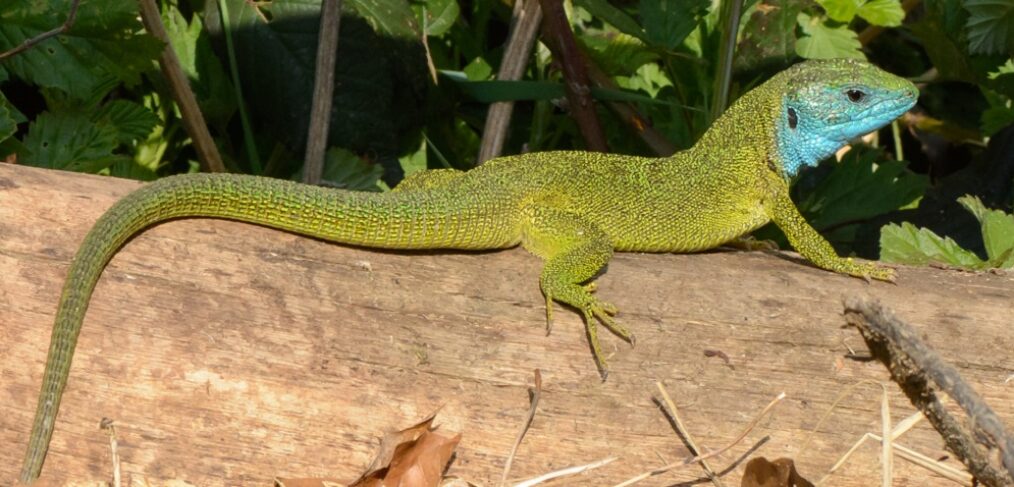
species of the week # 72 – european green lizard
The male green lizards really dress up to win over the females in spring. After their first moult in spring, they shed their inconspicuous winter coat. The different shades of green and blue of their splendid dress range from emerald green to cornflower blue. Some females are also blue in spring, but overall much more inconspicuous than the males.
|
Distribution status |
Extremely rare |
|
Remaining deposits |
Kaiserstuhl and near Passau |
|
Last sighting in rhineland-palatinate |
unknown |
|
Habitat |
Sunny, bushy biotopes on limestone, sandy or scree soils |
| Threat | Habitat loss, traffic, cats |
green lizards are agile, active and like to climb. They are relatively large compared to other native lizards and can grow up to 40 cm long. About two-thirds of this is accounted for by the tail, the end of which they can throw off in lizard fashion when attacking. Each of the rear tail vertebrae has a built-in predetermined breaking point. In case of great danger, the green lizard violently contracts the ring muscles running there and the tail piece falls off. The schwanzeigene nervous system then continues to work for up to twenty minutes, so that the dropped piece wriggles violently and attracts the attention of birds of prey, martens or cats. However, the lizard can only use this survival trick once, because the regrowing tail piece does not form new vertebrae, but only a long cartilage.
It was only a few years ago that cross-breeding experiments revealed that there are two different species of green lizard, both of which occur in Germany. They look very similar and can only be distinguished from each other as hatchlings. While european hatchlings are pure brown, the underside of the head of western hatchlings is already green.
The main reason for the sharp decline of the green lizards is the loss of their habitats. They need a combination of dense bushes with sun-exposed areas for egg-laying and thermoregulation. Small structures of dead wood or stones, for example brushwood or rock piles, are readily accepted as basking sites. Eggs are laid in loose sand, loam or loess soil at the end of 15-30 cm long, self-dug tunnels that reach 10-20 cm below the soil surface. Accordingly, these areas must not become overgrown or planted and must not be walked on or driven over.
Green lizards can live for 5-15 years. The mortality rate of young animals is between 82 and 90 percent in the first year, in unfavourable years even 100 percent. This is partly due to the fact that the track bed of railway lines has become their main habitat, because other areas with sunny scree and bushes are hardly available any more. Here they are often run over, also by the adjacent car traffic.
It would be important to create adequate replacement habitats for them. This includes low forest stands, structural improvement or restoration of suitable structures in overgrown areas and the creation of small structures such as brushwood or rock piles. To ensure long-term population security, these often very isolated habitats must be networked.
Here it goes to further exciting species of the week
Image: By Uoaei1 – Own work, CC BY-SA 4.0, https://commons.wikimedia.org/w/index.php?curid=39840199
